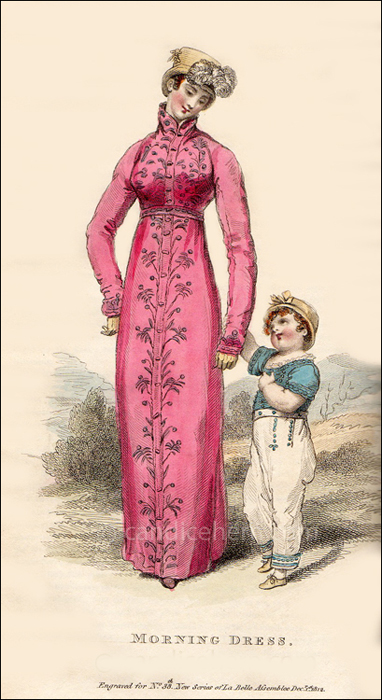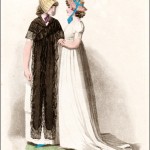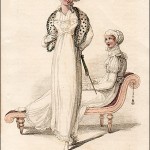La Belle Assemblée, December 1812.
“Morning Dress”
 Most of the ladies’ magazines of the period would now and then include children in their fashion prints. It is interesting to note children’s dress in these prints, though they are seldom mentioned in the descriptions.
Most of the ladies’ magazines of the period would now and then include children in their fashion prints. It is interesting to note children’s dress in these prints, though they are seldom mentioned in the descriptions.
This young lad, apparently old enough to wear trousers, wears a charming outfit, and his hat echoes the style as his mother’s hat.
But the star of this print is the fabulous pelisse, with its beautiful embroidery down the front and on the cuffs of the sleeves. Though this ensemble is called a Morning Dress in the print’s title, probably because the lady is shown with her child, it seems elegant enough to have been worn during the fashionable promenade in the late afternoon. In fact, at the end of the description, it is referred to as a “promenade costume.”
The print is described in the magazine as follows:
“A Merino cloth long pelisse of a very deep rose colour, ornamented with a superbly embroidered fancy border in front; it is fastened down the whole length of the figure with frogs and tassels to correspond; waist a moderate length, and elegant figured belt and tassels; long sleeves rather tight to the arm, finished at the cuff with an embroidery to correspond, as is also the collar, which stands up at the neck. York tan gloves, and slippers or half-boots. Some few elegantés adopt the half-boot in the colour of the dress, but this fashion is not general. A small straw hat turned up all round, and ornamented with two short ostrich feathers, which fall over in front. This truly elegant and fashionable order of promenade costume was furnished by Mr. S. Clark, Ladies Pelisse and Habit Maker, No. 37 Golden Square, whose taste in articles of this description has been so generally admired.”
Note that the designer was a man. At this time, male tailors still made habits and outerwear for ladies, though it was no longer their exclusive purview, as it had been earlier. You can see a riding habit also made by Mr. S. Clark here.







